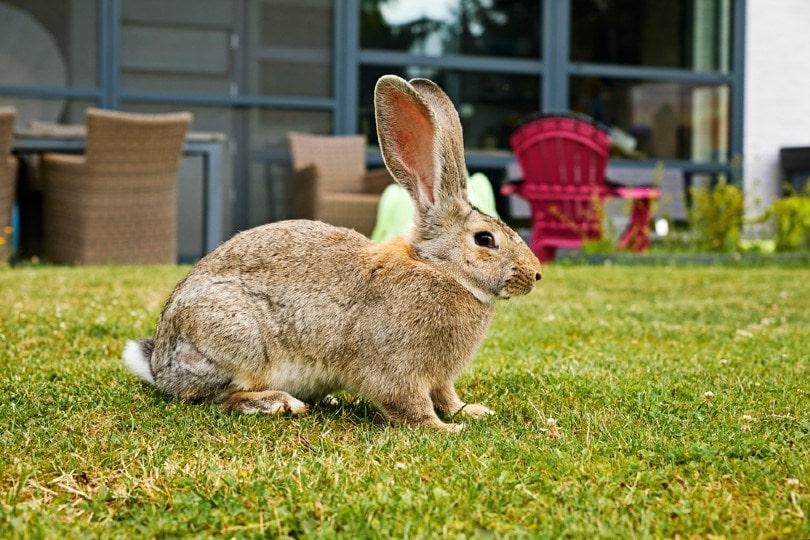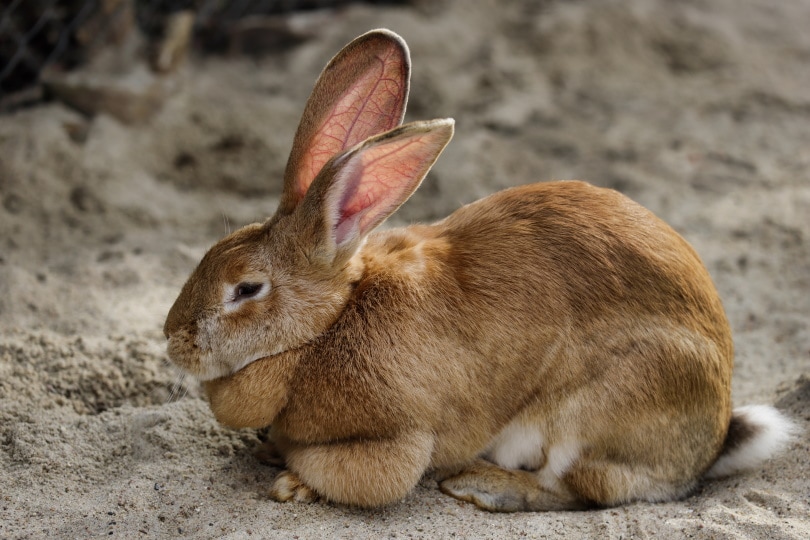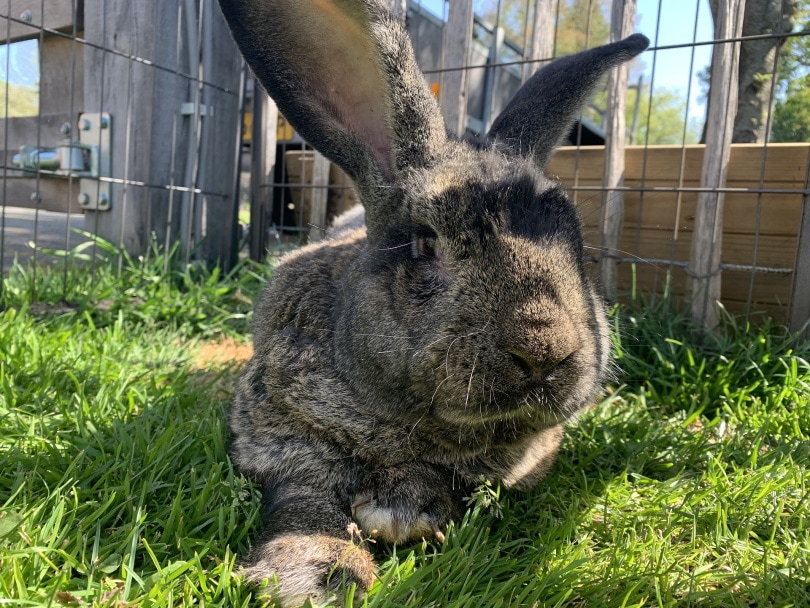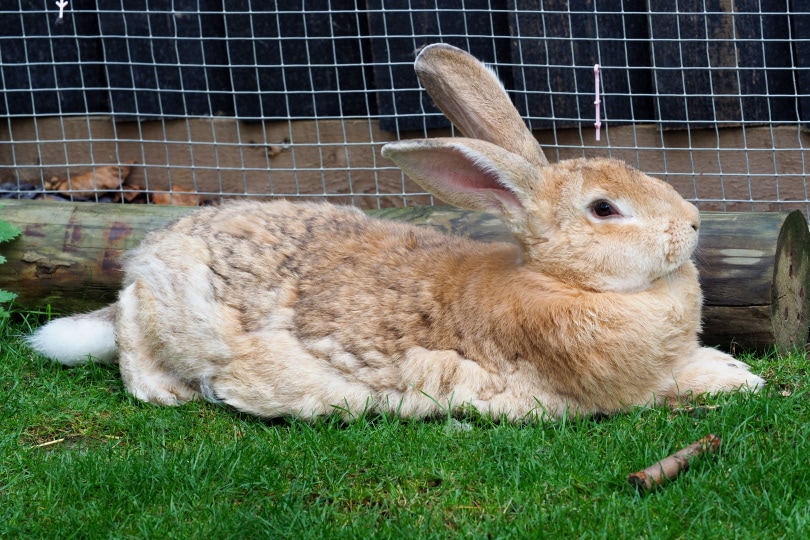
Click to Skip Ahead
Flemish Giants can look like quite the handful compared to the more modest-sized domestic rabbit breeds. Hopping along at a girthy 15+ pounds, they are the largest domestic rabbits and are frequently intimidating to smaller animals and inexperienced owners with kids. But give them time to show off their easy-going attitudes, and they’ll allay any uncertainties about their fit with the family.
Powerful in form yet soft in nature, the Flemish Giant rabbit is one of the most lovable companion animals around. If you’re considering a Flemish Giant for your next pet, we’ll explain what to expect in their care, living arrangements, and lifestyle.
Breed Overview
Size:
Giant
Weight:
15+ pounds
Lifespan:
5–8 years
Similar Breeds:
Belgian Hare
Suitable for:
Owners with large spaces for play, inexperienced owners wanting a laid-back rabbit
Temperament:
Passive, calm, friendly
Several theories exist surrounding the Flemish Giant’s origins and lineage. Many experts hypothesize links to the wild Stone and European Patagonian rabbits. The breed appeared in what is now northern Belgium over 400 years ago. Given its size and dense, glossy coat, it had loads of potential as a utility animal for meat and fur. Authentic Flemish Giant records emerged in the 1860s as the breed’s popularity expanded across Europe.
The first standards for the Flemish Giant appeared in 1893. A short time later, Americans began importing the rabbits. In 1915, a group established the National Federation of Flemish Giant Rabbit Breeders (NFFGRB) as the official resource for breeders. Today, the Flemish Giant remains popular as a pet and show animal, with breeders continuing to refine their stock as they vie for more sizeable and beautiful rabbits.
Flemish Giant Rabbit Breed Characteristics
How Much Do These Rabbits Cost?

Flemish Giants rabbits may not cost anything if you check through online forums, local listings, and social media groups. Adopting a rabbit from a local shelter is another low-cost option, as many rabbits cost under $100. The adoption route is easy with services like PetFinder, and you can often check their vaccination and desexing history.
Purchasing a Flemish Giant through a breeder comes with several perks alongside a higher price tag. Depending on the breeder, you may get pedigree information for new rabbits alongside vaccines (many of which cost over $150), starter supplies, and ongoing support.
The NFFGRB provides a comprehensive regional resource with perhaps the most up-to-date national breeder listing. Pet Flemish Giant rabbits often cost over $150, while show-quality specimens start around $250.
Temperament & Intelligence of the Flemish Giant Rabbit
With a body as large as a mid-sized dog, the Flemish Giant size is one of its best features. They’re an ideal cuddle partner and relaxed pet that enjoys lounging as much as playing with the family. While calm and generally friendly with children, they can respond with an aggressive nip or scratch if you handle them roughly, which isn’t challenging considering their size.
Flemish Giants are a curious and intelligent rabbit breed, allowing for easy training and acclimation. They get along with almost anyone and can pick up litter box training and tricks quickly. Command training is an enjoyable activity for the family and an excellent bonding opportunity for you and your rabbit.
Do These Rabbits Make Good Pets? 👪
Flemish Giants are exceptional pets. They’re an adaptable breed that tolerates children well and enjoys petting, playtime, and snuggling with their owners. Careful, purposeful handling is still crucial, as Flemish Giants stress easily and generally don’t like frequent lifting or trapping. Though they will let you know their displeasure with an icy attitude, foot thump, or grunt, they’ll always return wanting your attention and affection.
Their size is one of the primary causes of concern in owning Flemish Giants versus other rabbits. They have much larger appetites and need more space than the average bunny, which are vital considerations if you’ve previously had smaller breeds.
Does This Rabbit Get Along With Other Pets?
The Flemish Giant’s docile personality positions it as an excellent pairing for another laid-back animal. Their size makes them less of a target for predatory dog and cat breeds, facilitating a healthy dynamic among your animals. Even with smaller rabbits, the Flemish Giant typically prefers a peaceful, playful stance over being domineering.
Early introductions are ideal. When you give a Flemish Giant time to grow up with another pet, they can seamlessly cement a bond and enjoy a source of entertainment, comfort, and companionship for years.

Things to Know When Owning a Flemish Giant:
Food & Diet Requirements 🥕
As you might imagine from their size, Flemish Giants have one of the heaviest daily food requirements of any breed. They need fresh water at all times and unlimited hay (preferably Timothy hay), which should account for at least three-quarters of their diet. Their veggie and pellet consumption is roughly twice that of an average rabbit. Some even recommend free-feeding Flemish Giants pellets for the first year or so, watching and adjusting their intake based on their size and eating habits.
Flemish Giants can also tolerate more fruits and treats, though they should still be infrequent. Since they’re not particularly active, overeating, obesity, and related health issues are still a concern. Keeping up with activity and weighing your rabbit regularly to check for changes is crucial in maintaining a suitable diet and healthy size.
Habitat & Hutch Requirements 🏠
Adult Flemish Giants can easily stretch over 2 feet long, meaning they need plenty of room in their enclosure. An ideal space should be at least 3–4 feet wide and have enough room for 3–4 hops, putting it around 10 feet long. Flemish Giants can leap over 3 feet, so check the height of your indoor pen and upgrade as needed.
Enrichment activities are an essential element in any rabbit enclosure. Flemish Giants enjoy tunnels, hiding spots, toys, and spots to dig and forage. A large dog crate makes a suitable retreat, giving you a place to put bedding and cover as a hideaway for your rabbit. The living space should be out of direct sunlight and well-ventilated. Keep a steady eye on the thermostat, as the Flemish Giants don’t tolerate heat, especially as it rises above 90°F.
Exercise & Sleeping Needs 🐇
Flemish Giants aren’t a high-energy breed, but they still need a healthy amount of exercise. They need at least 3 hours of daily activity within their extra-large play spaces. Give them room to run, areas to jump up and down, and activities to explore.
Your Flemish Giant should have absorbent, consumable, and dust-free bedding with a litter box nearby. Cleaning the bedding of food, droppings, and other waste is a daily chore. Keeping your rabbit’s cage clean and odor-free will reduce the likelihood of disease and improve the comfort of everyone in the house.
Having a tray beneath the cage and room for a litter box can ease the clean-up chore in the sleeping area. Wire flooring can be painful on the heavier Flemish Giant’s feet, so you may want to position a plywood platform over it to ease their paws and hocks.

Training 🥎
You’ll appreciate the Flemish Giant’s intelligence when it comes time to train them. Litter box training is relatively straightforward. When they choose their ideal bathroom spot in the hutch, place a litter box and let them figure out the rest. Don’t forget to use safe-to-eat litter because rabbits will consume some of their droppings. Taking their training a step further, you can motivate your Flemish Giant with treats and clicker-train them to do tricks.
There are some habits you can’t train out. Like all rabbits, Flemish Giants need stimulating activities and chewable toys to satisfy their ever-growing teeth. Maintain adequate pet-proofing around the home when you let them roam. Keep all power cords, wooden furniture legs, houseplants, and hazardous materials off-limits.
Grooming ✂️
Flemish Giants are easy to groom, needing weekly brushes and regular nail trims to keep them comfortable in their cages and prevent injury. They’ll shed their summer and winter coats for several weeks and require twice as many weekly brushing sessions. Check and clean those enormous erect ears frequently. Look as far into the ear as possible, inspecting for damaging ear and fur mites.
Lifespan and Health Conditions 🏥
A healthy Flemish Giant can live 8–10 years when they receive proper care, nutrition, exercise, and interaction. The quality of the breeder will have an enormous bearing on their overall health. As a prospective owner, due diligence in researching responsible breeders upfront will pay off for years.
You should constantly monitor your Flemish Giant’s habits for changes in behavior to bring up with your vet. As a giant breed, they can be more prone to sore hocks and injury from falls, while their thick coat makes them more susceptible to heatstroke. Typical health concerns include those common to other rabbit breeds, such as GI stasis, mites, and malocclusion.
Male vs Female
Male and female Flemish Giants carry the familiar robust, V-shaped ears, arched backs, and rounded tails, but several notable differences exist between the sexes. One of the easiest to spot is the female dewlap. They use the overgrowth of skin beneath the head to keep their newborns warm, though many owners only see it as an extra grooming challenge.
Some owners note minor temperament differences between male and female Flemish Giants. Many find males to be more mild-mannered, while females stray toward the extremes of the emotional spectrum. They may act needy, bold, and sometimes more aggressive, but they can also be incredibly loving.

3 Little-Known Facts About the Flemish Giant Rabbit
1. A Flemish Giant Holds the Record for Largest Rabbit
Being the largest rabbit breed in the world, it only makes sense that the record holder for the biggest rabbit of all time is a Flemmie. Darius, a Flemish Giant with an English owner, received the official title in 2010. The enormous bunny stretched over 4 feet and weighed nearly 50 pounds.
Sadly, Darius’s owner lost him to thieves in 2021, and he was never recovered. But his legacy lives on in several offspring, all of which are significantly larger than your typical domestic rabbit.
2. Flemish Giants Were Initially Popular for Meat and Fur
Before we discovered their benefits as pets, breeders raised Flemish Giants for meat and fur production. Their generous bodies supplied thick, plush pelts, while their lean musculature provided a healthy source of protein.
With a dense bone structure, the actual supply of meat was relatively meager. The value was low, especially considering their enormous appetites, so Flemish Giants eventually lost popularity in that respect. For better meat production, many cross the Flemish with the Dutch and other rabbits with better meat-to-bone ratios.
3. Flemish Giants Come in Severn Colors
The NFFGRB and ARBA recognize seven spectacular Flemish Giant colors. Flemmies come in black, blue, light and steel grays, sandy, fawn, and white.
Final Thoughts
The Flemish Giant’s physical demands may be daunting for any pet owner, but their temperament never disappoints. They’re calm and pleasant, often more focused on cuddles than establishing dominance or playing tricks. Almost any family arrangement with kids and pets can benefit from a Flemish Giant, provided they have the room to spare.
Featured Image Credit: mariesacha, Shutterstock







